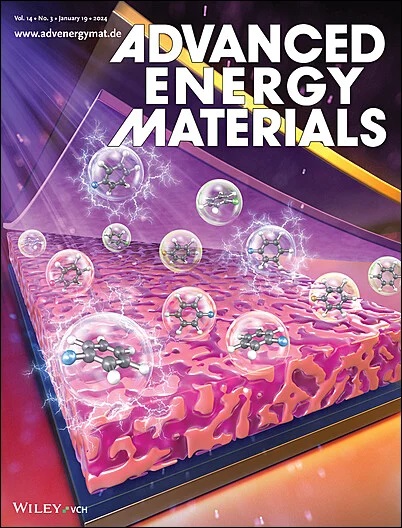揭示C60-O2相互作用对钙钛矿太阳能电池性能和表征的影响
IF 24.4
1区 材料科学
Q1 CHEMISTRY, PHYSICAL
引用次数: 0
摘要
C60是高效p-i-n钙钛矿单结和多结太阳能电池中普遍存在的电子传输层(ETL)。本文表明,C60 ETL暴露于环境O2会导致非辐射复合显著增加,影响常用表征技术的结果,如稳态和瞬态光致发光(PL)、瞬态表面光电压以及电流密度-电压测量。基于PL和He-I紫外光发射光谱测量,并结合密度泛函数理论计算和漂移扩散模拟,提出O2快速插入C60 ETL,导致钙钛矿/C60界面上深阱态的形成和载流子平衡的改变。研究结果表明,该效应是可逆的,但如果忽视,可能会误导实验解释,强调了设备制造和表征过程中氧气管理的重要性。此外,研究表明,这种相互作用使得空气中简单的PL测量可以作为一种新的传感方法来评估C60上SnOx缓冲层的阻挡层质量。因此,这项研究不仅突出了钙钛矿太阳能电池的关键劣化机制,并对C60 ETL和O2之间潜在的相互作用提供了更深入的了解,而且为未来的选择性接触优化提供了实用的途径。本文章由计算机程序翻译,如有差异,请以英文原文为准。

Unveiling the Impact of C60–O2 Interaction on the Performance and Characterization of Perovskite Solar Cells
C60 is the prevalent electron-transport layer (ETL) in high-efficiency p-i-n perovskite single-junction and multi-junction solar cells. Here, it is demonstrated that the exposure of the C60 ETL to ambient O2 results in significantly increased non-radiative recombination, influencing results from commonly applied characterization techniques such as steady-state and transient photoluminescence (PL), transient surface photovoltage, as well as current density-voltage measurements. Based on PL and He-I UV photoemission spectroscopy measurements and supported by density functional theory calculations and drift-diffusion simulations, it is proposed that O2 rapidly intercalates into the C60 ETL, causing the formation of deep trap states and an altered charge carrier balance at the perovskite/C60 interface. The findings reveal that the effect is reversible but can mislead experimental interpretations if disregarded, emphasizing the importance of O2 management during device fabrication and characterization. Furthermore, it is demonstrated that this interaction enables simple PL measurements in air to serve as a novel sensing method for evaluating the barrier layer quality of the SnOx buffer layer atop C60. This study thereby not only highlights a critical deterioration mechanism in perovskite solar cells and provides a deeper understanding of the underlying interaction between the C60 ETL and O2 but also offers practical avenues for future selective contact optimizations.
求助全文
通过发布文献求助,成功后即可免费获取论文全文。
去求助
来源期刊

Advanced Energy Materials
CHEMISTRY, PHYSICAL-ENERGY & FUELS
CiteScore
41.90
自引率
4.00%
发文量
889
审稿时长
1.4 months
期刊介绍:
Established in 2011, Advanced Energy Materials is an international, interdisciplinary, English-language journal that focuses on materials used in energy harvesting, conversion, and storage. It is regarded as a top-quality journal alongside Advanced Materials, Advanced Functional Materials, and Small.
With a 2022 Impact Factor of 27.8, Advanced Energy Materials is considered a prime source for the best energy-related research. The journal covers a wide range of topics in energy-related research, including organic and inorganic photovoltaics, batteries and supercapacitors, fuel cells, hydrogen generation and storage, thermoelectrics, water splitting and photocatalysis, solar fuels and thermosolar power, magnetocalorics, and piezoelectronics.
The readership of Advanced Energy Materials includes materials scientists, chemists, physicists, and engineers in both academia and industry. The journal is indexed in various databases and collections, such as Advanced Technologies & Aerospace Database, FIZ Karlsruhe, INSPEC (IET), Science Citation Index Expanded, Technology Collection, and Web of Science, among others.
 求助内容:
求助内容: 应助结果提醒方式:
应助结果提醒方式:


